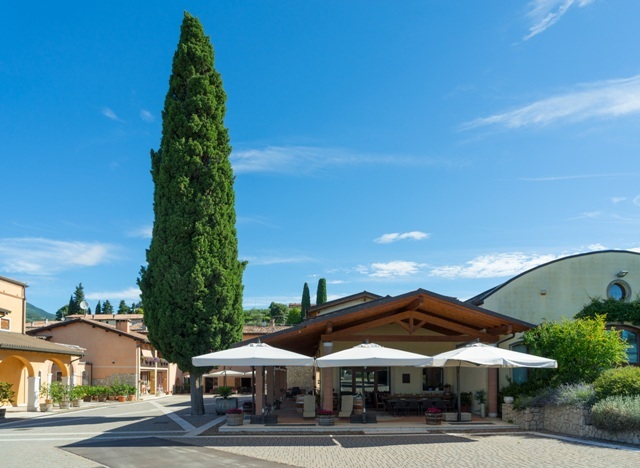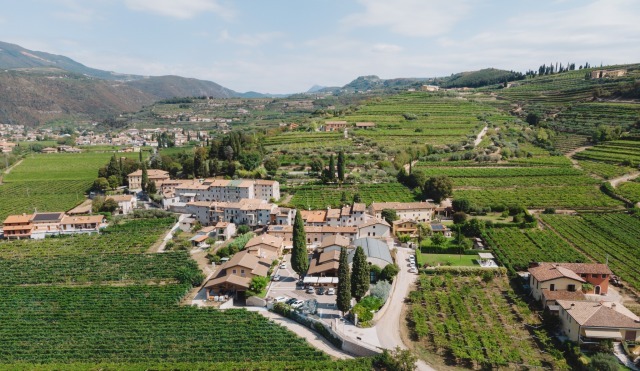organic wine, biodynamic wine, Demeter wine, na... Organic wine estates Azienda Agricola Cubi, organic wines Veneto, or...
Azienda Agricola Cubi, organic wines Veneto, organic red wines Veneto

The history of the Azienda Agricola Valentina Cubi
began in 1969 when the couple Valentina and Giancarlo Cubi bought 7 hectares of vineyards with their savings in Valpolicella, a hilly and partly mountainous landscape north of Verona. Giancarlo's family has been involved in viticulture in the Valpolicella area since the 19th century and Valentina also made her home here and over time she discovered her passion for oenology.
They knew from the start that this investment would be a lifelong one and that they would only cultivate their vineyards using organic farming techniques. This included the use of biodynamic preparations. Finally, the official recognition and certification as an organic winery followed around 2014.

The Azienda Agricola Valentina Cubi in Fumane - Valpolicella
The Cubi family and their employees see themselves as wine craftsmen, they plant their vineyards with young vines themselves, grow them for several years until the first harvest, tend the soil and the vines by hand from cutting in winter to the grape harvest in autumn. They don't buy any grapes from other winegrowers because that's their credo
"Good wine is made in the vineyard".
All organic wines of Azienda Agricola Valentina Cubi receive a name dedicated to the areas and history of Valpolicella.

Le village Fumane au centre des vignobles du Valpolicella
THE VINEYARDS
have grown over the years to a size of 10 hectares through the purchase of another 3 hectares. They are terraced and are literally a stone's throw from Lake Garda. Cooling breezes from the lake keep the vineyards continuously aerated and keep fungal pressure down, while differences between day and night temperatures ensure the grapes retain their freshness while reaching full maturity. The soils on these terraces contain a high rock content with clay that can store water. For this reason, an irrigation system is completely absent. Consequently, this is dry viticulture
Vineyard Casterna
The 1 ha vineyard, which was replanted in 1997, forms the back garden of the winery. At 170m it is the lowest part of the property and is planted with Corvina, Rondinella and Corvinone all Guyot trained. It was one of the first vineyards of Valentina Cubi where experiments with organic preparations were tried. The space between the rows is permanently planted with cover crops to improve soil aeration, stimulate the growth of bio-organisms and attract insects, which are the natural enemies of the most common vine diseases.
The soils are of ancient alluvial origin and have a high percentage of calcareous clay interspersed with gravel and sand, resulting in fragrant, fruity wines.
Monte Tenda
this location is on top of a hill and benefits from the cool breeze of Lake Garda which is only 4km away. The oldest part of the vineyard was planted with Rondinella in the 1973s, while Corvina was planted about 20 years ago.
Both are pergola structures that were once considered unsuitable for quality wine growing. However, since the onset of climate change, it has been found to cope much better with the erratic and hot weather patterns than Guyot vines and is capable of producing high quality grapes.
The soils of Monte Tenda are exceptionally rich in limestone, with a high proportion of rock interspersed with sand. This soil type produces wines that are characterized by freshness and elegance with mineral notes and a fine tannin core.
Monte Crosetta
the soil structure of this vineyard is very similar to that of Monte Tenda. Located at an altitude of 260 m, the soil consists of a high rock and limestone content. It was planted with Corvina about 20 years ago and was one of the last vineyards with pergola vines before this system was banned for new plantings.
But pergola, when combined with under-yielding old vines, is much better able to cope with the potential effects of climate change and is much more adaptable to the vine's needs than wire rope vineyards. The horizontal canopy provides shade while the freely hanging grapes are constantly aerated by the breezes coming from Lake Garda.
Vineyard Rasso
the vineyard is at 290 m altitude, which guarantees constant air movement. The first Corvina vines were planted as a pergola 28 years ago, while later plantings were trained as Guyot vines. The soils of the Rasso vineyard are rich in limestone and have a very stony skeleton on the surface.
![Biowein [pur] Hartl - organic wine shipper](/WebRoot/Store7/Shops/87b180e2-5584-4f7d-8168-acd5dfe63e0b/Styles/Sharp[3]/logo.png)



